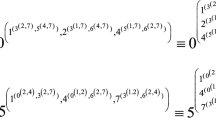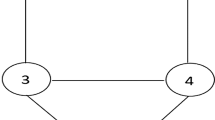Abstract
Adiabatic quantum computers like the D-Wave 2000Q can approximately solve the QUBO problem, which is an NP-hard problem, and have been shown to outperform classical computers on several instances. Solving the QUBO problem literally means solving virtually any NP-hard problem like the traveling salesman problem, airline scheduling problem, protein folding problem, genotype imputation problem, thereby enabling significant scientific progress, and potentially saving millions/billions of dollars in logistics, airlines, healthcare and many other industries. However, before QUBO problems are solved on quantum computers, they must be embedded (or compiled) onto the hardware of quantum computers, which in itself is a very hard problem. In this work, we propose an efficient embedding algorithm, that lets us embed QUBO problems fast, uses less qubits and gets the objective function value close to the global minimum value. We then compare the performance of our embedding algorithm to that of D-Wave’s embedding algorithm, which is the current state of the art, and show that our embedding algorithm convincingly outperforms D-Wave’s embedding algorithm. Our embedding approach works with perfect Chimera graphs, i.e., Chimera graphs with no missing qubits.








Similar content being viewed by others
References
Adachi, S.H., Davenport, D.M., Henderson, M.P.: Quantum-assisted training of neural networks. US Patent App. 14/702,203 (2015)
Albash, T., Lidar, D.A.: Adiabatic quantum computation. Rev. Modern Phys. 90(1), 015002 (2018)
Amin, M.H.: Methods of adiabatic quantum computation. US Patent 8,504,497 (2013)
Amin, M.H., Steininger, M.F.: Adiabatic quantum computation with superconducting qubits. US Patent 7,135,701 (2006)
Applegate, D.L., Bixby, R.E., Chvatal, V., Cook, W.J.: The Traveling Salesman Problem: A Computational Study. Princeton University Press, Princeton (2006)
Barends, R., Shabani, A., Lamata, L., Kelly, J., Mezzacapo, A., Las Heras, U., Babbush, R., Fowler, A.G., Campbell, B., Chen, Y., et al.: Digitized adiabatic quantum computing with a superconducting circuit. Nature 534(7606), 222 (2016)
Baruah, S., Bertogna, M., Buttazzo, G.: Multiprocessor Scheduling for Real-time Systems. Springer, Berlin (2015)
Biamonte, J.D., Berkley, A.J., Amin, M.: Physical realizations of a universal adiabatic quantum computer. US Patent 8,234,103 (2012)
Bian, Z., Chudak, F., Israel, R.B., Lackey, B., Macready, W.G., Roy, A.: Mapping constrained optimization problems to quantum annealing with application to fault diagnosis. Front. ICT 3, 14 (2016)
Bian, Z., Chudak, F., Macready, W., Roy, A., Sebastiani, R., Varotti, S.: Solving sat and maxsat with a quantum annealer: foundations and a preliminary report. In: International Symposium on Frontiers of Combining Systems, pp. 153–171. Springer, Berlin (2017)
Blum, A., Rivest, R.L.: Training a 3-node neural network is NP-complete. In: Advances in Neural Information Processing Systems, pp. 494–501 (1989)
Boothby, T., King, A.D., Roy, A.: Fast clique minor generation in chimera qubit connectivity graphs. Quantum Inf. Process. 15(1), 495–508 (2016)
Britt, K.A., Humble, T.S.: High-performance computing with quantum processing units. ACM J. Emerg. Technol. Comput. Syst. (JETC) 13(3), 39 (2017)
Cai, J., Macready, W.G., Roy, A.: A practical heuristic for finding graph minors. Preprint (2014). arXiv:1406.2741
Carrillo, H., Lipman, D.: The multiple sequence alignment problem in biology. SIAM J. Appl. Math. 48(5), 1073–1082 (1988)
Chickering, D.M., Geiger, D., Heckerman, D., et al.: Learning Bayesian networks is NP-hard. Technical Report, Citeseer (1994)
Choi, V.: Minor-embedding in adiabatic quantum computation: I. The parameter setting problem. Quantum Inf. Process. 7(5), 193–209 (2008)
Choi, V.: Minor-embedding in adiabatic quantum computation: II. Minor-universal graph design. Quantum Inf. Process. 10(3), 343–353 (2011)
Cook, S.A.: The complexity of theorem-proving procedures. In: Proceedings of the 3rd Annual ACM Symposium on Theory of Computing, pp. 151–158. ACM, New York (1971)
Cristianini, N., Shawe-Taylor, J., et al.: An Introduction to Support Vector Machines and Other Kernel-based Learning Methods. Cambridge University Press, Cambridge (2000)
Dasgupta, S.: The hardness of \(k\)-means clustering. Department of Computer Science and Engineering, University of California, San Diego (2008)
Dill, K.A., MacCallum, J.L.: The protein-folding problem, 50 years on. Science 338(6110), 1042–1046 (2012)
Dubois, O., Dequen, G.: A backbone-search heuristic for efficient solving of hard 3-sat formulae. IJCAI 1, 248–253 (2001)
Esteve, D., Vion, D., Devoret, M., Urbina, C., Joyez, P., Pothier, H., Orfila, P.F., Aassime, A., Cottet, A.: Superconducting quantum-bit device based on josephson junctions. US Patent 6,838,694 (2005)
Etschmaier, M.M., Mathaisel, D.F.: Airline scheduling: an overview. Transp. Sci. 19(2), 127–138 (1985)
Goodrich, T.D., Sullivan, B.D., Humble, T.S.: Optimizing adiabatic quantum program compilation using a graph-theoretic framework. Quantum Inf. Process. 17(5), 118 (2018)
Grover, L.K.: A fast quantum mechanical algorithm for database search. In: Proceedings of the 28th Annual ACM Symposium on Theory of Computing, pp. 212–219. ACM, New York (1996)
Hamilton, K.E., Humble, T.S.: Identifying the minor set cover of dense connected bipartite graphs via random matching edge sets. Quantum Inf. Process. 16(4), 94 (2017)
Huang, W., Yu, J.X.: Investigating TSP heuristics for location-based services. Data Sci. Eng. 2(1), 71–93 (2017)
Imamog, A., Awschalom, D.D., Burkard, G., DiVincenzo, D.P., Loss, D., Sherwin, M., Small, A., et al.: Quantum information processing using quantum dot spins and cavity QED. Phys. Rev. Lett. 83(20), 4204 (1999)
Kane, B.E.: A silicon-based nuclear spin quantum computer. Nature 393(6681), 133 (1998)
Keating, T., Goyal, K., Jau, Y.Y., Biedermann, G.W., Landahl, A.J., Deutsch, I.H.: Adiabatic quantum computation with Rydberg-dressed atoms. Phys. Rev. A 87(5), 052314 (2013)
King, A.D., Israel, R.B., Bunyk, P.I., Boothby, T.J., Reinhardt, S.P., Roy, A.P., King, J.A., Lanting, T.M., Evert, A.J.: Systems and methods for embedding problems into an analog processor. US Patent App. 15/487,295 (2017)
Kleinberg, J., Tardos, E.: Algorithm Design. Pearson Education India, Noida (2006)
Klymko, C., Sullivan, B.D., Humble, T.S.: Adiabatic quantum programming: minor embedding with hard faults. Quantum Inf. Process. 13(3), 709–729 (2014)
Landahl, A.: Adiabatic quantum computing. In: APS Four Corners Section Meeting Abstracts (2012)
Lewis, M., Glover, F.: Quadratic unconstrained binary optimization problem preprocessing: theory and empirical analysis. Networks 70(2), 79–97 (2017)
Li, Y., Willer, C., Sanna, S., Abecasis, G.: Genotype imputation. Ann. Rev. Genom. Hum. Genet. 10, 387–406 (2009)
Macready, W., Roy, A.P.: Systems and methods that formulate problems for solving by a quantum processor using hardware graph decomposition. US Patent 9,875,215 (2018)
Nielsen, M.A., Chuang, I.: Quantum Computation and Quantum Information. AAPT (2002)
Papadimitriou, C.H.: Computational Complexity. Wiley, London (2003)
Pittman, T., Jacobs, B., Franson, J.: Probabilistic quantum logic operations using polarizing beam splitters. Phys. Rev. A 64(6), 062311 (2001)
Pla, J.J., Tan, K.Y., Dehollain, J.P., Lim, W.H., Morton, J.J., Jamieson, D.N., Dzurak, A.S., Morello, A.: A single-atom electron spin qubit in silicon. Nature 489(7417), 541 (2012)
Potok, T.E., Schuman, C.D., Young, S.R., Patton, R.M., Spedalieri, F., Liu, J., Yao, K.T., Rose, G., Chakma, G.: A study of complex deep learning networks on high performance, neuromorphic, and quantum computers. In: Workshop on Machine Learning in HPC Environments (MLHPC), pp. 47–55. IEEE, New York (2016)
Rieffel, E.G., Venturelli, D., O’Gorman, B., Do, M.B., Prystay, E.M., Smelyanskiy, V.N.: A case study in programming a quantum annealer for hard operational planning problems. Quantum Inf. Process. 14(1), 1–36 (2015)
Roy, A.P.: Systems and methods that formulate embeddings of problems for solving by a quantum processor. US Patent 9,501,747 (2016)
Shmygelska, A., Hoos, H.H.: An ant colony optimisation algorithm for the 2D and 3D hydrophobic polar protein folding problem. BMC Bioinformat. 6(1), 30 (2005)
Shor, P.W.: Algorithms for quantum computation: discrete logarithms and factoring. In: 1994 Proceedings., 35th Annual Symposium on Foundations of Computer Science, pp. 124–134. IEEE, New York (1994)
Shor, P.W.: Polynomial-time algorithms for prime factorization and discrete logarithms on a quantum computer. SIAM Rev. 41(2), 303–332 (1999)
Thom, M.C., Roy, A.P., Chudak, F.A., Bian, Z., Macready, W.G., Israel, R.B., Boothby, T.J., Yarkoni, S., Xue, Y., Korenkevych, D., et al.: Systems and methods for analog processing of problem graphs having arbitrary size and/or connectivity. US Patent App. 15/448,361 (2017)
Turing, A.M.: On computable numbers, with an application to the entscheidungsproblem. a correction. Proc. Lond. Math. Soc. 2(1), 544–546 (1938)
Venturelli, D., Mandra, S., Knysh, S., O’Gorman, B., Biswas, R., Smelyanskiy, V.: Quantum optimization of fully connected spin glasses. Phys. Rev. X 5(3), 031040 (2015)
Zagoskin, A.M.: Qubit using a josephson junction between s-wave and d-wave superconductors. US Patent 6,459,097 (2002)
Zagoskin, A.M.: Quantum computing method using magnetic flux states at a Josephson junction. US Patent 6,563,311 (2003)
Zaribafiyan, A., Marchand, D., REZAEI, S.S.C.: Method and system for generating an embedding pattern used for solving a quadratic binary optimization problem. US Patent App. 15/344,054 (2017)
Author information
Authors and Affiliations
Corresponding author
Additional information
Publisher's Note
Springer Nature remains neutral with regard to jurisdictional claims in published maps and institutional affiliations.
This research was supported in part by an appointment to the Oak Ridge National Laboratory ASTRO Program, sponsored by the US Department of Energy and administered by the Oak Ridge Institute for Science and Education.
Rights and permissions
About this article
Cite this article
Date, P., Patton, R., Schuman, C. et al. Efficiently embedding QUBO problems on adiabatic quantum computers. Quantum Inf Process 18, 117 (2019). https://doi.org/10.1007/s11128-019-2236-3
Received:
Accepted:
Published:
DOI: https://doi.org/10.1007/s11128-019-2236-3




